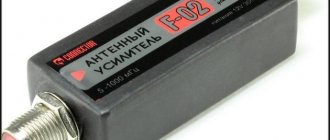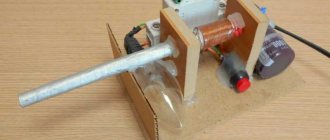A simple voltmeter circuit includes a measuring block and a set of resistors. This is a minimal kit, suitable only for making preliminary measurements. With such a tester you can measure the voltage in the outlet or the charge level of the battery. Devices that provide high-class measurements require a more complex circuit diagram. Making a homemade digital voltmeter is quite possible for those who can hold a soldering iron in their hands and know the graphical representation of radio elements.
Voltmeter
What types are there?
Devices of this kind are devices that perform direct readings when determining the voltage value. The main requirement for such devices is considered to be high internal resistance. When connected in parallel to the area where the voltage value needs to be tested, it should not have any effect on it.
If we classify devices that measure voltage, we can highlight the following points:
- feature (principle) of work;
- purpose of application;
- structure and methods of use.
Devices are divided into two types: electromechanical and electronic. The first is a structure that includes an electromechanical mechanism and a device that displays the result. The latter are divided into analog and digital devices.
Attention! The name “electromechanical” means that all these structures: electromagnetic, magnetoelectric and others, produce a deflection of the electrical measuring system under the influence of electricity.
Electromechanical voltmeter of electromagnetic system
Analog devices include an amplifier in addition to a set of shunts. This is a unit that allows you to increase the lower measurement interval and increase Rin, as well as measure DC and AC voltage.
A digital voltmeter displays data in digital format. The circuit allows the voltage to be converted into an electrical code using an analog-to-digital device.
Testers by purpose allow you to perform the following options:
- DC potential difference measurement;
- determining the magnitude of AC voltage;
- impulse voltage measurements;
- phase-sensitive measuring devices;
- universal devices;
- devices of selective (selective) action.
The structure, structure and methods of use allow the use of voltmeters for stationary placement, panel placement and for measurements in the field (portable).
Digital voltmeter modules
The big advantage of the blocks is the relatively low price and the absence of supply voltage; they are powered by a voltage that is simultaneously measured. The manufacturer gives a voltage range of 2.6 - 30 V. First, let's test them at different voltage values. Powered by converter and lithium-ion batteries. We will compare the readings with the UNI-T UT210E meter, as well as with ANENG. The modules have a small potentiometer on the board to correct the readings.
It happens that tuning a module at low voltage also requires correction in the upper operating ranges of this module. To increase accuracy, you can use the potentiometer to calibrate the readings against a reference device and after the procedure, we recommend adding a drop of nail polish to immobilize it. After calibration they will become quite accurate.
The accuracy of these indicators will be acceptable in many devices, especially considering the low price of these modules (can be purchased for less than 100 rubles). The indicators automatically switch the range - after exceeding the value of 9.99 V, only decimal parts are displayed, that is, one digit after the decimal point.
Microprocessor based voltmeter
How to connect a voltmeter
The operation of such devices is based on the functioning of a built-in microprocessor. The system provides service options that not only provide various testing modes, but also determine the characteristics of the signals under test. The operating memory contains a program that controls the operation of the voltmeter.
Important! Voltmeters are the most suitable instruments for carrying out the entire range of diagnostics that a microprocessor can provide.
Microprocessor voltmeters have the following advantages:
- increased measurement accuracy class;
- simplicity and ease of device control;
- admissibility of working with measured values in the context of mathematical functions;
- internal software self-monitoring of calibration and diagnostics of measurement accuracy;
- maintaining statistics of results.
Block diagram of a voltmeter with a digital processor
An AC millivoltmeter, assembled with your own hands on a microprocessor, will consist of the following components:
- input device: amplifier, filters, attenuator (attenuation unit);
- ADC – analogue to digital signal converter;
- digital result display device;
- device control node.
Often the input unit includes an AC to DC voltage measuring converter.
Information. Digital voltmeters on a microprocessor are testers that have wide measurement limits, manual or automatic selection of the measured range. They can measure not only the voltage of both types of current, but also determine the resistance of resistive elements.
Multi-limit instrument
Anyone who has repeatedly encountered transistor designs and circuits knows that very often with a voltmeter it is necessary to measure circuits with voltages from tens of fractions of one volt to hundreds of volts. A simple homemade device with one resistor will not do this, so you will have to connect several elements with different resistances to the circuit. So that you understand what we are talking about, we suggest that you familiarize yourself with the diagram located below:
It shows that there are four resistors installed in the circuit, each of which is responsible for its own measurement range:
- From 0 volts to one.
- From 0 volts to 10V.
- From 0 V to 100 volts.
- From 0 to 1000 V.
The value of each resistor can be calculated based on Ohm's law. The following formula is used here:
- Rп is the resistance of the measuring unit, take, for example. 500 Ohm;
- Up is the maximum voltage of the measured limit;
- Ii is the current strength at which the needle deflects to the end of the scale, in our case - 0.0005 amperes.
For a simple voltmeter from a Chinese ammeter, you can choose the following resistors:
- for the first limit – 1.5 kOhm;
- for the second – 19.5 kOhm;
- for the third – 199.5;
- for the fourth – 1999.5.
But the relative resistance value of this device will be equal to 2 kOhm/V. Of course, the calculated values do not coincide with the standard ones, so resistors will have to be selected close in value. Next, the final adjustment is carried out, during which the device itself is calibrated.
Schematic diagram of a voltmeter
What does a voltmeter measure and how to use it
In order to make an electronic millivoltmeter using an ADC, you can take a microcircuit such as CA3162. A tester assembled according to this circuit allows you to measure voltage in the range from 0 – 100 V. The CA3162E microassembly is an ADC with Uin. Max. = 999 mV. There is also a logical circuit that produces the result in the form of 3 alternating binary-decimal 4-bit codes.
Attention! In this assembly there is a function for polling the circuit capacity during dynamic display. For this purpose, the common terminals of the anodes are used.
Voltmeter circuit for ADC CA31162
How to convert a DC voltmeter into AC voltage
The circuit shown in Figure 1 is a DC voltmeter. To make it variable or, as experts say, pulsating, it is necessary to install a rectifier in the design, with the help of which the direct voltage is converted into alternating voltage. In Figure 2, an AC voltmeter is shown schematically.
This scheme works like this:
- when there is a positive half-wave at the left terminal, diode D1 opens, D2 in this case is closed;
- voltage passes through the ammeter to the right terminal;
- when the positive half-wave is at the right end, then D1 closes and no voltage passes through the ammeter.
A resistor Rd must be added to the circuit, the resistance of which is calculated in exactly the same way as the other elements. True, its calculated value is divided by a coefficient equal to 2.5-3. This is the case if a half-wave rectifier is installed in the voltmeter. If a full-wave rectifier is used, then the resistance value is divided by a coefficient: 1.25-1.5. By the way, the diagram of the latter is shown in Figure 3.
Details
To assemble a voltmeter, the following components are required:
- microcircuits CA31162 and KR514ID2;
- transistors KT361 – 3 pcs.;
- constant resistors with a power of 0.125 W, nominal: 1 kOhm - 4 pcs.; 470 Ohm – 7 pcs.; 470 kOhm – 1 pc.; 4.7 kOhm – 1 pc.; 820 kOhm – 1 pc.;
- variable resistors: 5.1 kOhm (adjustment of the “limit” mode) and 47 kOhm (adjustment of the “zero setting”)
- capacitors: 0.22 mF – 2 pcs.; 6800 pF; electrolytic at 100 mF * 150 V;
- AL324B indicators – 3 pcs.
Parts can be taken used, with leads of sufficient length for successful installation. Key transistors are selected with the same transition resistances or with similar values.
Assembly of a lamp voltmeter
Such a device is designed to measure high-frequency voltage inside the circuit. At home, you can make a simple voltmeter to measure high-frequency indicators, but such a device will be very different from factory instruments. Using such a device it is impossible to measure alternating voltages, which is due to the specific design. With proper assembly and measurements within acceptable limits, the device error is about 1%.
For assembly you will need:
- diode detector;
- measuring bridge with lamp L2;
- warning lamp;
- switch;
- DC amplifier;
- galvanometer;
- correction circuit.
The measurement range of a lamp voltmeter varies depending on the nominal resistance of the resistors indicated in the diagram R1-R11. This version of the voltmeter is considered the most difficult to manufacture independently, since assembly requires precise calculations taking into account the characteristics of the diode detector.
Preparing the board
The parts are mounted on a homemade board made of foil PCB. To secure the elements, holes are drilled in the board. You can make a board on which you can assemble a digital voltmeter yourself. The prepared elements are first placed on a piece of thick cardboard. The leads need to be pierced through the cardboard. After this, the connecting conductors are drawn according to the diagram. Next, the drawing is transferred to the textolite. The connecting tracks are covered with varnish or enamel, after which the board is etched in a solution and washed thoroughly.
The solution is prepared from the following components:
- 100 ml hydrogen peroxide (3%);
- 30 g (1 tbsp) citric acid;
- 5 g (tsp) table salt.
For your information. If necessary, you can add water and heat the solution, this will help the process go faster. This proportion is calculated for a volume of solution that allows processing textolite with an area of 10 cm2.
Double integration voltmeters
The double integration digital DC voltmeter operates on the principle of periodic repetition. In this case, the return of the source code in the chain is carried out automatically. This system operates exclusively with direct current. In this case, the frequency is pre-rectified and supplied to the output device.
Sampling errors are not taken into account in voltmeters. Thus, moments of mismatch of counting pulses may occur. As a result, one parameter can be very different at the beginning and end of the interval. However, as a rule, the error is not critical due to the operation of the converter.
A particular problem is noise interference. As a result, it can significantly distort the voltage indicator. Ultimately, this is reflected in the magnitude of the pulse, namely its duration. Thus, these types are not very popular among digital voltmeters.
Assembly and configuration
The board is placed in a suitable-sized case and secured with screws. It is also necessary to provide space for the battery and installation of a charging socket. The front panel displays the terminals for connecting measuring probes and the working axes of variable resistors. An indicator for displaying results is also installed outside the housing.
A homemade voltmeter on the CA31162 does not need any special settings. Resistor R4 on the device calibrates “zero” at a similar value of Uin. Resistor R5 calibrates the measurement limits using a previously known value of Uin.
The homemade design of digital voltmeters, made with high-quality components, is not inferior to factory products. Similar circuits can be assembled using ADCs such as KR572PV2, KR572PV5. Instead of a decoder based on TTL logic specified in the diagram, it is permissible to use parts based on CMOS (MOS) logic, having previously coordinated such an assembly with the ADC chip.
How to properly connect a voltmeter
Anyone who does not know, but wants to check the voltage on some part of the electrical network, must ask the question - how to connect a voltmeter? This is actually a serious question, the answer to which lies in a simple requirement - the voltmeter must be connected only in parallel with the load. If a serial connection is made, the device itself will simply fail and you may receive an electric shock.
Read also: Makita hr2450 rotary hammer do-it-yourself repair
The thing is that with such a connection the current strength acting on the measuring device itself decreases. At this resistance, it does not change, that is, it remains large. By the way, never confuse a voltmeter with an ammeter. The latter is connected to the circuit in series to reduce the resistance to a minimum.
And the last question on the topic is how to use a voltmeter that you made yourself. So, your device has two probes. One is connected to the neutral circuit, the second to the phase. You can also check the voltage through the socket, having previously determined which socket is powered by zero and which by phase. Or connect the device in parallel to the area being measured. The arrow of the measuring block will show the voltage value in the network. This is how they use this homemade measuring device.
We consider simple circuits of digital voltmeter and ammeter, built without the use of microcontrollers on the CA3162, KR514ID2 microcircuits. Typically, a good laboratory power supply has built-in instruments - a voltmeter and an ammeter. A voltmeter allows you to accurately set the output voltage, and an ammeter will show the current through the load.
Old laboratory power supplies had dial indicators, but now they should be digital. Nowadays, radio amateurs most often make such devices based on a microcontroller or ADC chips like KR572PV2, KR572PV5.
DIY ammeter shunt
Many home electricians are dissatisfied with industrial testers, so they think about how to make a voltmeter from an ammeter, as well as how to increase the functionality of the industrial tester.
For this purpose, a special shunt can be made. Before you begin, you should calculate the shunt for the microammeter and find a material with good conductivity. Of course, for greater measurement accuracy, you can simply purchase a milliammeter, but such devices are quite expensive, and they are rarely used in practice.
Recently, testers designed for high voltage and resistance have appeared on sale. They do not require a shunt, but their cost is very high. For those who use a classic tester made in Soviet times, or use a homemade one, a shunt is simply necessary.
Application
Thermometer -55…+150С with resolution 0.1С
As a sensor we use the LM35 sensor chip in the following configuration:
The approximate price of the chip is about 200 rubles ($6) for LM35CZ.
Schematic diagram of a thermometer
Operating temperature range, error and chip index
| marking* | temperature range | typical error at 25C** | TO-46 body | TO-92 body | SO-8 housing (SMD) | housing TO-220 |
| LM35 | -55…+155 | 0.4 | LM35H | |||
| LM35A | -55…+155 | 0.2 | LM35AH | |||
| LM35C | -40…+110 | 0.4 | LM35CH | LM35CZ | ||
| LM35CA | -40…+110 | 0.2 | LM35CAH | LM35CAZ | ||
| LM35D | 0…+100 | 0.4 | LM35DH | LM35DZ | LM35DM | LM35DT |
Note:
*A index means improved accuracy and linearity. **at the edges of the range the error is approximately 2 times higher, for more details see
I received from AliExpress a couple of electronic built-in voltmeters model V20D-2P-1.1 (DC voltage measurement), the price is 91 cents each. In principle, you can now find it cheaper (if you look hard enough), but it’s not a fact that this will not be to the detriment of the build quality of the device. Here are its characteristics:
- operating range 2.5 V - 30 V
- glow color red
- overall size 23 * 15 * 10 mm
- does not require additional power (two-wire version)
- there is a possibility of adjustment
- refresh rate: about 500ms/time
- Promised measurement accuracy: 1% (+/-1 digit)
And everything would be fine, put it in place and use it, but I came across information about the possibility of improving them - adding a current measurement function.
Digital Chinese voltmeter
I prepared everything I needed: a two-pole toggle switch, output resistors - one MLT-1 for 130 kOhm and a second wire resistor for 0.08 Ohm (made from a nichrome spiral with a diameter of 0.7 mm). And the whole evening, according to the found circuit and instructions for its implementation, I connected this equipment with wires to a voltmeter. To no avail. Either there was not enough insight in understanding what was left unsaid and incompletely drawn in the material found, or there were differences in the schemes. The voltmeter didn't work at all.
Connecting the digital voltmeter module
I had to unsolder the indicator and study the circuit. What was needed here was not a small soldering iron, but a tiny one, so it took quite a bit of fiddling. But over the next five minutes, when the entire scheme became available for review, I understood everything. In principle, I knew that this was where I needed to start, but I really wanted to solve the issue “easy.”
Step-by-step instruction
So , step one - an SMD resistor with a resistance of 130 kOhm is removed from the circuit, standing at the input of the positive power wire, between the diode and the trimming resistor 20 kOhm.
We connect the resistor to the voltmeter-ammeter
Second . On the freed contact, on the side of the trimmer, a wire of the desired length is soldered (for testing, conveniently 150 mm and preferably red)
Unsolder the SMD resistor
Third . A second wire (for example, blue) is soldered to the track connecting the 12 kOhm resistor and the capacitor from the “ground” side.
Characteristics of a car voltmeter
How to make a voltmeter? How should a made electronic voltmeter be connected to the cigarette lighter, what is the connection diagram? First, let's take a look at the main characteristics of the device.
Device Description
As we have already said, a digital voltmeter is designed to measure voltage. An analog device is a device equipped with a pointer indicator and a scale. Today, such devices are used very rarely; digital devices have recently become increasingly popular.
Kinds
Combined device with thermometer
As for the types themselves, you can find either simple devices or combined ones on sale.
- Simple. Such a device is characterized by relatively small dimensions, as a result of which its installation is allowed virtually anywhere in the vehicle. Therefore, a voltmeter of this type is usually connected to the cigarette lighter. Thus, the device allows you to monitor the voltage level of the battery both when the engine is turned off and when the engine is running. If you decide to install a voltmeter with your own hands, then it will be useful for you to know that when the engine is off, the voltage should be 12.5 volts, while when the engine is running - 13.5-14.5 volts. If this parameter is higher or lower, you will need to diagnose the on-board network of the machine. A voltmeter in a car will be indispensable, be it a dial version or a digital car one, it will become an indispensable attribute for those who like to relax in nature. With its help, you will always know what voltage is in the network of your vehicle and how to prevent it from falling below normal. It's no secret that relying on standard low battery indicators is not entirely correct, since such devices usually warn the driver when it is too late to take any action. The voltmeter circuit can be connected to a special remote display, which can be installed anywhere in the car, for example, directly in the center console.
- Combined. As for combined instruments, they can be additionally equipped with thermometers, tachometers, ammeters, etc. Thanks to the thermometer, the driver will always be able to know what the temperature is inside the car or outside, in the engine compartment of the vehicle. With the help of a tachometer, the car enthusiast will always have the opportunity to monitor the number of engine revolutions. As a rule, if you buy a combined gadget with a tachometer, the kit should include all the necessary sensors that allow you to measure this indicator from 50 degrees below zero to 120 degrees of heat. In general, the procedure for installing a device of this type in your car is not a particularly complicated procedure, which you can easily cope with on your own.
Loading …
Video
I consider the purchase of these voltmeters a success, but it’s just a pity that their current price in that store has increased significantly, almost 3 dollars apiece. Author Babay iz Barnaula.
A miniature Chinese voltmeter can simplify the process of measuring voltage and the amount of current consumed on a power supply or homemade charger. Its cost rarely exceeds 200 rubles, and if you order it from China through affiliate programs, you can also get a significant discount.
Designs and details of pointer voltmeters
The voltmeter was mounted in a plastic case from a photo relay “FR-75A” TU 32-1501-75. A view of the layout of parts is shown in Fig. 6. Box dimensions are about 122x88x48 mm. View of the assembled device photo at the beginning of the article. Microammeter M4200 without built-in resistors; if present, the resistors must be removed from the microammeter body.
The microammeter can be replaced with M42300 or another similar one, for example, M4260. M2003-M1. In order not to redo the scale, current-limiting resistors can be recalculated for other range values, for example: 0.5, 5.0, 50, 500 Volts.
Switch SA1 is a quadruple P2K with dependent fixation with two groups of contacts connected in parallel. Before installation, the switch should be disassembled, the contacts should be cleaned of oxides, the plastic housings of the buttons should be cleaned from the inside and washed with ethyl alcohol. When assembling the switch, the rubbing plastic and metal parts can be lubricated with thick silicone grease for office equipment.
The thermistor RT1 is installed on textolite racks, applied with a resistance of about 300 Ohms from the electronic ballast of a compact electroluminescent lamp "Camelion LH26-AS-M E27 T3", designated as MZ5. Any similar one with a resistance of 270 ... 330 Ohms at room temperature will do. The more powerful the lamp, the lower the resistance the thermistor can be installed in it. When forming its hard leads, do not damage the thermistor body.
Resistor R1 is wirewound with a power of 5…7 W. During operation and overload of the device, this resistor does not heat up; the use of conventional metal film and carbon resistors in its place is undesirable due to splashing and burnout of the conductive layer at the time of overload, which causes the resistance of the resistors to change, followed by their breakage. The remaining resistors of any type for general use, R3 - R5 are soldered to the corresponding contacts of SA1.
Instead of 1N4007S diodes, you can install any of the series 1N4001 - 1 N4007, UF4001 - UF4007, KD209, KD243, KD247. The diodes are soldered to the petal contacts of the microammeter. The glow discharge lamp HL1, a small-sized imported orange glow, was chosen from several dozen, the brightest was a miniature lamp from the backlight of the keys of imported rotary switches. The MTX-90 thyratrons also had good results, but their sizes are much larger and the viewing angle is narrower.
The lamp is glued to the inside of the transparent housing cover with cyanoacrylic glue. The E1 sensor is made from the metal body of an imported germanium transistor type SFT352; keep in mind that none of its terminals are connected to the transistor body. You can use domestic transistors MP39, GT402 and similar ones with slightly different case sizes.
The multi-colored probes XI, X2 are equipped with heat-shrinkable tubes of different colors, which makes them easier to identify when several measuring instruments are used on the workbench. Before setting up the voltmeter, set the meter needle with the adjusting screw to the zero scale division. The setup begins with the selection of resistor R1.
If you cannot find a single wire-wound resistor of the required resistance, you can install two wire-wound resistors connected in series: the first with a power of 5 W with a resistance of 47 or 51 Ohms, the second with a power of 2...3 W with a resistance of 3...12 Ohms, you can also use a homemade one.
Afterwards, the resistance of resistors R3 – R5 is selected one by one. If there are no powerful resistors of suitable resistance, you can install resistors of slightly higher resistance in their place, and connect 2 in parallel with each of these resistors. series-connected resistors with a power of 0.25 W with a resistance of hundreds of kOhms - units of MOhms.
After the necessary checks of the manufactured device, do not test the protection on RT1 with unnecessary overloads out of curiosity. If you need to find the phase wire of the network wiring with this voltmeter, it is advisable to switch SA1 to the “750 V” position, which will increase the safety of its use.
Testing a new circuit
Now, according to the diagram and this photo, we “hang” an addition to the voltmeter: a toggle switch, a fuse and two resistors. The main thing here is to correctly solder the newly installed red and blue wires, however, not only them.
We convert the voltmeter block into an A-meter
But here there are more wires, although everything is simple:
“ payload ” – a pair of connecting wires connects the electric motor “ separate power supply for the voltmeter ” – battery with two more wires “ power supply output ” – a couple more wires
After applying power to the voltmeter, “0.01” was immediately displayed; after applying power to the electric motor, the meter in voltmeter mode showed a voltage at the output of the power supply equal to 7 volts, then switched to ammeter mode. The switching was performed when the power supply to the load was turned off. In the future, instead of a toggle switch, I will install a button without locking, it will be safer for the circuit and more convenient for operation. I was pleased that everything worked on the first try. However, the ammeter readings differed from the multimeter readings by more than 7 times.
Chinese voltmeter - ammeter after modification
Here it turned out that the wirewound resistor, instead of the recommended resistance of 0.08 Ohm, has 0.8 Ohm. I made a mistake in the measurements during its manufacture in the counting of zeros. I got out of the situation like this: the crocodile with the negative wire from the load (both black) moved along a straightened nichrome spiral towards the input from the power supply, the moment when the readings of the multimeter and the now modified ampere-voltmeter coincided and became the moment of truth. The resistance of the involved section of the nichrome wire was 0.21 Ohm (measured with a multimeter attachment at the “2 Ohm” limit). So it didn’t even turn out bad that instead of 0.08 the resistor turned out to be 0.8 Ohm. Here, no matter how you count, according to the formulas, you still have to adjust. For clarity, I recorded the result of my efforts on a video.
Shunt for an ammeter - how to make it yourself, calibrate and expand the capabilities of the tester
Measuring current is a fairly important procedure for calculating and testing electrical circuits. If you are creating a device with power consumption at the level of charging a mobile phone, a regular multimeter is enough to measure.
A typical inexpensive household tester has a current measurement limit of 10 A.
Most of these devices have an additional connector for measuring larger quantities. When rearranging the measuring cable, you probably haven’t thought about why you need to organize an additional circuit, and why you can’t just use the mode switch?











